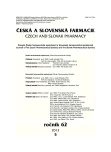Influence of temperature and concentration of a surfactant on pharmaceutical availability
Authors:
Petra Herdová; Zuzana Vitková; Jarmila Oremusová; Alexandra Kodadová
Authors‘ workplace:
Univerzita Komenského v Bratislave
; Farmaceutická fakulta, Katedra galenickej farmácie
; PharmDr. Petra Herdová, PhD. (∗) • Zuzana Vitková • Alexandra Kodadová
Published in:
Čes. slov. Farm., 2013; 62, 223-226
Category:
Original Articles
Overview
This study aimed to analyze the influence of surfactant concentration and temperature on drug liberation from hydrogels and their flow properties. The surfactant benzethonium chloride (BZCl) was used in concentrations of 0.01, 0.1 and 0.5 % (w/w), while the drug chlorhexidine dihydrochloride (CHX) was used in a concentration of 0.1 % (w/w). Chitosan (CHIT) in 2.5 % (w/w) concentration was used as a gel-creating substance. The drug and surfactant liberation were evaluated within the temperature range of 25–40 °C. The largest amounts of both of them were liberated at the temperature of 40 °C. Through the concentration changes it was possible to obtain statistically significant differences (P < 0.05) between the liberation of CHX and BZCl. An analysis of the flow properties revealed that the character of the plastic system was not influenced by the changing concentration of the surfactant. The experimental results led to the conclusion that the optimum composition of the gel was as follows: 2.5 % (w/w) CHIT + 0.1 % (w/w) CHX + 0.01 % (w/w) BZCl.
Keywords:
chlorhexidine dihydrochloride •benzethonium chloride • chitosan • liberation • critical micelle concentration
Sources
1. Rangel-Yagui C. O., Pessoa A., Tavares L. C. Micellar Solubilization of Drugs. J Pharm Pharmaceut Sci 2005; 8(2), 147–165.
2. Bartovská L. Fyzikální chemie povrchových a koloidných soustav. 5 vyd. Praha: VŠCHT 2005; 244, 186–191.
3. Kim H-U., Lim K-H. A model on the temperature dependence of critical micelle concentration. Colloids and Surfaces A: Phys. Chem. Engin. Aspects, 2004; 235(1–3), 121–128.
4. Chen L-J., Lin S-Y., Huang C.C., Chen E. M. Temperature dependence of critical micelle concentration of polyoxyethylenated non- ionic surfactants. Colloids and Surfaces A: Phys. Chem. Engin. Aspects,1998; 135(1–3), 175–181.
5. Schramm L. L., Stasiuk E. N., Marangoni D. G. Surfactants and their applications. Annu. Rep. Prog. Chem., Sect. C, 2003; 99, 3–48.
6 http://pubchem.ncbi.nlm.nih.gov/summary/summary.cgi?sid= 162180433&loc=es_rss#x395[cit. 3.9.2013]
7. http://cameochemicals.noaa.gov/chemical/19856 [cit. 26.8.2013]
8. NTP Toxicology and Carcinogenesis Studies of Benzethonium Chloride (CAS No. 121-54-0) in F344/N Rats and B6C3F1 Mice (Dermal Studies). Natl Toxicol Program Tech Rep Ser. 1995; 438, 1–220.
http://www.ncbi.nlm.nih.gov/pubmed/12595925 [cit. 20.8.2013]
9. Kiselovičová M. Štúdium interakcií katiónového tenzidu s vybranými liečivami (lokálne anestetiká). Diplomová práca. Bratislava: Univerzita Komenského, Farmaceutická fakulta, 2012; 62.
Labels
Pharmacy Clinical pharmacologyArticle was published in
Czech and Slovak Pharmacy

2013 Issue 5
Most read in this issue
-
Standard prescriptions for extemporaneously produced medicinal preparations in pharmacies
VI. Collection Neues Rezeptur-Formularium - A combination of grapefruit seed extract and concentrated cranberry juice as a potential antimicrobial preservative for the improvement of microbiological stability of hypromellose gel
- Influence of temperature and concentration of a surfactant on pharmaceutical availability
- Evaluation of liberation of caffeine from dermal semisolids drugs
